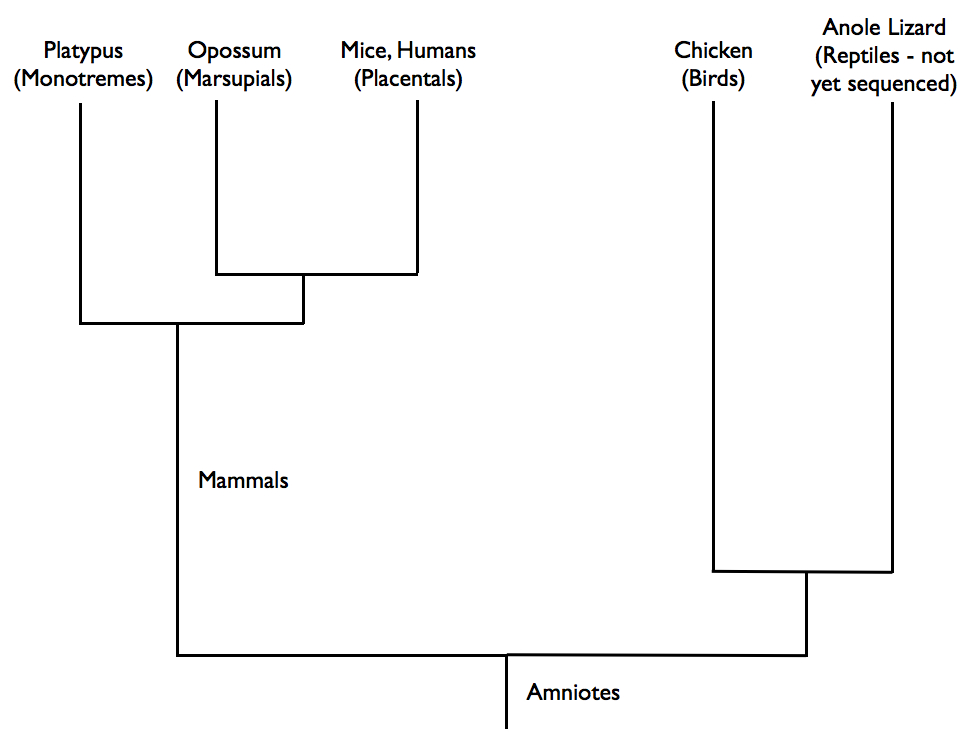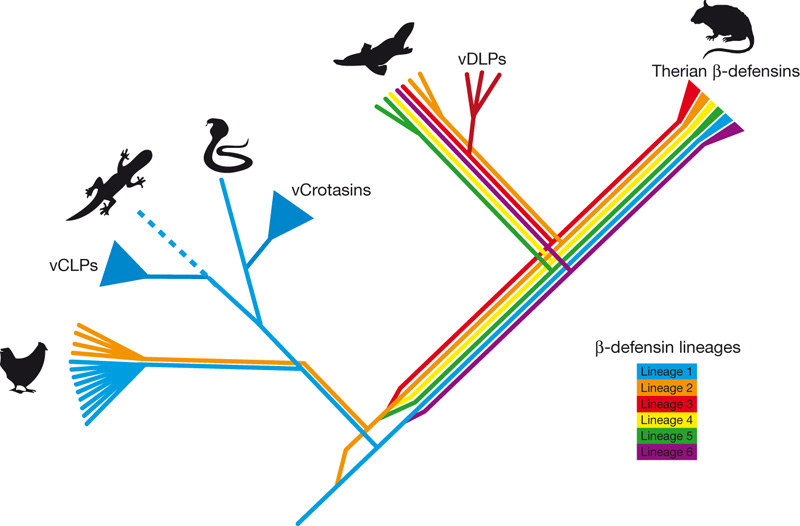I haven't contributed a single thing to the platypus genome project, but since my desk sits one floor above where people and robots broke the platypus DNA into chunks, cloned those chunks into bacteria, sequenced the pieces of DNA, and used massive amounts of computing power to assemble the stretches of sequence into a complete genomic whole, I'm going to consider myself somewhat of an authority on the subject and tell you what's wrong with other people's ideas about the platypus.
The genome sequence of the platypus was published Thursday in Nature, and from the press headlines, you could be excused for thinking that genomics has in fact confirmed that the platypus is a freak of nature: part bird, part reptile, and part mammal. The animal certainly looks like it - the platypus has the webbed feet and bill of a duck, and venomous spines and rubbery eggs that remind us of reptiles, but it has fur and feeds its young with milk, so it must be a mammal. The confusing press headlines might even lead you to believe that we sequenced the platypus genome just to figure out what this thing is, when the truth is, as we'll see below, that the genome sequence has essentially confirmed what evolutionary biologists have already deduced about the position of the platypus on the tree of life.
Is the platypus part bird, part reptile part mammal, an amalgam of very different groups of animals? Is it a primitive mammal that resembles the early ancestors of all mammals? Can we figure out just what this creature is by gazing at its genome?

The Platypus is a Genuine Mammal, not an Amalgam
The platypus Ornithorhynchus anatinus is part of a group of mammals known as Monotremes, who last shared a common ancestor with us between 160 and 200 million years ago. At that point, one mammalian line split off to give rise to today's monotremes, while another eventually led to the marsupial and placental mammals. What this means, of course, is that the platypus is as distant from that ancient ancestor as we are - humans, kangaroos, and platypuses are all modern mammals.
However some traits of the platypus can be considered primitive, if you take primitive to mean 'resembles the ancestral form' (instead of the more colloquial meaning 'less advanced'). The most obvious example is that the platypus lays eggs, something which ancient mammals also did, but which most modern mammals no longer do. Egg-laying is an ancestral trait that has persisted in this particular evolutionary line, a trait which the platypus inherited from the egg-laying, reptile-like ancestors of all mammals - in that sense, it's primitive.
Other features of the platypus aren't primitive, and have absolutely nothing to do with the fact that all mammals shared a common ancestor with today's birds and reptiles. The venomous spines possessed by the male platypus are not there because of some reptile ancestor that had venomous spines; early mammals probably had no venom, and evolutionary biologists have long insisted that this interesting platypus feature is likely an independent evolutionary invention. Venomous spurs are no more reptilian than the human lack of fur: we don't have fur, and our reptile ancestors didn't have fur, but our bare skin is not a trait inherited from fur-less reptile-like ancestors, it's a trait we lost recently in our evolutionary history.
The same is true of the 'duck bill', which has nothing at all to do with any ancestors the platypus (and all mammals) share with birds: it's a separate invention, a highly developed electrical sensor that the platypus uses to search for food, much like the bill of a paddlefish (which is also an independent invention). Despite the bill and the webbed feet, the platypus is not "part bird" (as USA Today proclaimed), and its flat tail does not make it part beaver either (beavers are placental mammals, more closely related to us than to a platypus).
The platypus is not part anything: it's 100% mammal, with some primitive traits of ancient mammals, like egg laying, and a few newly invented traits like the bill, the webbed feet, and the venomous spines.
The big story hidden in the platypus genome is that evolutionary biologists were right about what the platypus is: by looking at its genome, we can see which platypus traits are ancestral, and which are new inventions (derived is the proper term), only now in much more detail because we can see how the genes involved changed.
Gazing Into The Platypus Genome
So what can we learn about this critter by gazing at its genome? By making the right comparisons, we can figure out which genes were in the shared ancestors of birds, reptiles, and mammals, but which have been lost in the line leading to marsupial and placental mammals. Below you can see the evolutionary relationships between major groups of mammals, as well as birds and reptiles. For each of these major branches, except reptiles, we have at least one good genome sequence, which I've indicated in the figure. (The Anole lizard genome sequence is in progress, so right now we have to make many of the key evolutionary comparisons with the chicken genome.)

The comparison works like this: If a particular gene is present in the platypus and the chicken genomes, but not in other mammal groups, then we conclude that this gene was present in the shared ancestor of all these groups, but was at some point lost in the line leading to marsupial or placental mammals. Or, if a gene is present in the platypus, but not in other mammals or birds, then we conclude that this particular gene was not present in that shared ancestor of all these groups; it was newly derived at some point in the evolutionary line leading to monotremes. Of course, there is an alternate explanation: that same gene could have been present in the last common ancestor, but lost in birds, marsupials, and placental mammals, which is less likely but still possible. You get the picture - with the right set of genomes in hand, one can make all sorts of comparisons like this. (And, just to clarify, when I say gene here, I also mean variants of a gene, or any other genetic feature we can look at in the genome.)
By doing this, we can find genes for ancestral mammalian traits that are preserved in the platypus, but which have been lost in marsupials and placental mammals. Genes contributing to egg-laying are the obvious candidates, and in the platypus genome we find several genes involved in egg development that have previously only been found in fish, birds, and reptiles. What this means is that these particular genes, present in the early ancestors of all mammals, were lost in marsupials and placentals, but preserved in the monotreme line. Before the genome sequence came out, the story evolutionary biologists would tell you was this: egg-laying is a trait that's been preserved in monotremes in an unbroken line from early egg-laying ancestors, while the rest of the mammals lost that egg-laying ability. And now the genome sequence bears this story out.
We can find another example of an ancestral trait in the platypus genome: the sex chromosomes. While humans have one X chromosome (although you may have two non-identical copies of this particular X chromosome), the platypus has 5 - that's right, 5 X chromosomes. These X chromosomes look nothing like the human one; instead, they resemble the sex chromosomes of birds (and probably some reptiles, but we have less sequence data for reptiles). Again, this is probably another example of the ancestral state being largely preserved in the platypus. The last common ancestor of birds, reptiles, and mammals probably had a similar sex chromosome setup, but in the evolutionary line leading to marsupial and placental mammals, that setup has changed significantly.
The Independent Invention of Venom
What about venom? Few other mammals have venom, and the most plausible evolutionary scenario is that early mammals did not have venom - it arose independently in the platypus, and not by inheritance from a venomous reptile ancestor. Again, what we find in the genome supports this scenario: the platypus does not have the exact same venom genes found in reptiles, meaning that the platypus did not inherit its venom-producing ability from an ancient venomous ancestor. Platypus venom is a great example of what biologists call convergent evolution, the independent evolutionary invention of similar traits in different groups of animals.
The platypus genome confirms this independent invention story, but with a very fascinating twist: there is a set of non-venom genes which have been recruited at least twice in evolutionary history to make venom genes: at least once in reptiles, such as poisonous snakes, and once in the platypus.
To understand what's going on here, you need to know what venom is made of. Venom is largely a mixture of various proteins that do nasty things to the prey or competitors of venomous creatures. The genes coding for these venom proteins are very similar to, and actually derived from hormone gene families, such as one family called 'beta-defensin'. We have beta-defensin genes, which make up part of our immune system. Reptiles and the platypus also have these genes. In venomous reptiles, some of the beta-defensin genes have been modified to make venom. What the platypus genome shows is that at some point in the non-venomous evolutionary history of the platypus, beta-defensin genes were again recruited to make venom, just as they were in reptiles, but in a completely independent event.
In other words, platypus venom is not primitive; it's not a reptilian trait that the platypus inherited from the last common ancestor shared by mammals and reptiles. Contrary to what you may have read in the press, venom genes are not signs of a link between the platypus and reptiles. Here is the evolutionary tree researchers produced from the sequences of beta-defensin genes (you can read Ryan Gregory's great primer on how to read these trees):

This tree shows, based on the sequence data of the genes themselves, that the platypus beta-defensin genes descend from the ancestor of all mammals, and not from a venomous reptile.
So the genome sequence tells us what biologists have been saying all along: the platypus is not evolution's Frankenstein, not an amalgam of spare parts from different species. The platypus is a marvelous example of how evolution works, preserving useful traits through long stretches of evolutionary time, while also inventing new traits, sometimes over and over again from the same raw materials in very different lineages. That's as true of our history as it is of platypus history.
But is this why we sequenced the platypus genome, just to learn about its evolutionary story? I'm a big advocate of answering basic research questions like this, yet this is not the only valuable aspect of the platypus genome. One of the best ways to learn about the functions of the various parts of the human genome is through triangulation, by comparing our genome with other genomes that are spaced at various evolutionary distances from ours. One case that stands out right now is that of the immune system genes in the platypus, which promise to teach about the evolution of the immune system in mammals, which in turn can shed light on how our own immune system functions and goes awry.
The platypus may look odd, but its genome fits nicely into an already well-established evolutionary picture, and in spite of this mammal's strangeness, it has much to teach us about ourselves.
For more on platypus evolution, and the misleading language found in both the press and the scientific papers themselves, read Ryan Gregory's take.




Comments